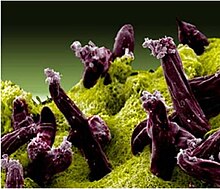| Plasmodium gallinaceum | |
|---|---|

| |
| Scanning electron micrograph of invading mosquito midgut | |
| Scientific classification | |
| Domain: | Eukaryota |
| Clade: | Diaphoretickes |
| Clade: | SAR |
| Clade: | Alveolata |
| Phylum: | Apicomplexa |
| Class: | Aconoidasida |
| Order: | Haemospororida |
| Family: | Plasmodiidae |
| Genus: | Plasmodium |
| Species: | P. gallinaceum |
| Binomial name | |
| Plasmodium gallinaceum Brumpt, 1935 | |
Plasmodium gallinaceum is a species of the genus Plasmodium (subgenus Haemamoeba) that causes malaria in poultry.
Description
This species was described by Alexandre Joseph Emile Brumpt (1877–1951) a French professor of parasitology during a trip to Ceylon (now Sri Lanka).
Stages
Oocysts must develop inside the vector host. They are not transmissible – if they enter an avian host they will not develop.
Sporozoites are the transmission stage. If they enter an avian host they may infect.
Vectors
Aedes aegypti is a vector.
P. gallinaceum manipulates A. aegypti to increase its own chances of success. Koella et al., 2002 finds that oocysts in the gut increase the volume of each blood meal. This lowers the chances of disgorgement of the parasites into the final host – chicken (Gallus gallus domesticus) – which is important because oocysts can't infect. This prolongs the average duration of oocyst residence in the vector, increasing their chance of successfully maturing to the transmission stage.
On the other hand sporozoites do the opposite: They decrease the volume of meals, increasing the number of meals taken, shortening the time they must continue to be in the vector, and increasing their chance of being successfully disgorged into a final host. Because this is the transmittable (infectious) stage that is desirable.
This appears to generalize to P. gallinaceum and any combination of mosquito and avian.
Virulence factors
Circumsporozoite protein (CSP) is required for host invasion. Warburg et al., 1992 provides a monoclonal antibody against CSP and demonstrates efficacy. The complete inhibition of sporozoite colonization of Aedes aegypti salivary glands they achieved could be due to the antibody itself blocking contact between the sporozoites and the gland surface, however the antibody's binding is inhibited by a particular CSP motif, suggesting antibody efficacy is due to its anti-CSP effect. This 15-amino acid motif is one found by the original Dame et al., 1984 discovery of CSP which contains the 5-length CSP Region I.
Pathology
Infection produces severe changes in blood plasma composition. Williams 2005 finds large changes in plasma proteins at 8 days post infection. There is a reduction in albumin, α2-globulin, and creatinine. Meanwhile, there is an increase in γ1-globulin, γ2-globulin, total plasma protein, and total plasma enzyme. (The enzyme increase is due to an increase in aspartate aminotransferase, glutamate dehydrogenase, and γ-glutamyltransferase.)
References
- "Plasmodium Infection". The Merck Veterinary Manual. 2006. Retrieved 2007-07-03.
- Brumpt, Emile (1936). "Etude Expérimentale du Plasmodium gallinaceum Parasite de la Poule Domestique. Transmission de ce Germe par Stegomyia fasciata et Stegomyia albopicta" [Experimental Study on the Plasmodium gallinaceum Parasite of the Domesticated Chicken : Transmission of the Pathogen by Stegomyia fasciata and Stegomyia albopicta]. Annales de Parasitologie: 597–620.
- ^
- These reviews:
- • Lefevre, Thierry; Thomas, Frederic (2008). "Behind the scene, something else is pulling the strings: Emphasizing parasitic manipulation in vector-borne diseases". Infection, Genetics and Evolution. 8 (4). Elsevier B.V.: 504–519. doi:10.1016/j.meegid.2007.05.008. ISSN 1567-1348. PMID 17588825. S2CID 5933503.
- • Brodeur, Jacques; Poulin, Robert; Thomas, Frederic (2010). "Host manipulation by parasites: a multidimensional phenomenon". Oikos. 119 (8). John Wiley & Sons Ltd. (Nordic Society Oikos): 1217–1223. Bibcode:2010Oikos.119.1217T. doi:10.1111/J.1600-0706.2009.18077.X. S2CID 36582693.
- ...cite Koella:
- • Koella, Jacob; Rieu, Linda; Paul, Richard (2002). "Stage-specific manipulation of a mosquito's host-seeking behavior by the malaria parasite Plasmodium gallinaceum". Behavioral Ecology. 13 (6). Oxford University Press (OUP) (International Society for Behavioral Ecology): 816–820. doi:10.1093/BEHECO/13.6.816. eISSN 1465-7279. ISSN 1045-2249. LCCN 90650061. OCLC 41963900. S2CID 86576999.
- ^ Ghosh, Anil Kumar; Jacobs-Lorena, Marcelo (2009-07-14). "Plasmodium sporozoite invasion of the mosquito salivary gland". Current Opinion in Microbiology. 12 (4). Elsevier: 394–400. doi:10.1016/j.mib.2009.06.010. ISSN 1369-5274. PMC 2759692. PMID 19608457. NIHMS# 124325.
- Baldacci, Patricia; Ménard, Robert (2004-08-31). "The elusive malaria sporozoite in the mammalian host". Molecular Microbiology. 54 (2). Wiley-Blackwell: 298–306. doi:10.1111/j.1365-2958.2004.04275.x. ISSN 0950-382X. PMID 15469504. S2CID 30488807.
- ^
- These reviews...
- • Alkadi, Hussien (2007). "Antimalarial Drug Toxicity: A Review". Review. Chemotherapy. 53 (6). Karger: 385–391. doi:10.1159/000109767. eISSN 1421-9794. ISSN 0009-3157. PMID 17934257. S2CID 7888082.
- • LaPointe, Dennis; Atkinson, Carter; Samuel, Michael (2012). "Ecology and conservation biology of avian malaria". Annals of the New York Academy of Sciences. 1249 (1 The Year in Ecology and Conservation Biology). Wiley-Blackwell (New York Academy of Sciences (NYAS)): 211–226. Bibcode:2012NYASA1249..211L. doi:10.1111/j.1749-6632.2011.06431.x. ISSN 0077-8923. PMID 22320256. S2CID 1885904.
- ...cite this study:
- • Williams, R. (2005). "Avian malaria: clinical and chemical pathology of Plasmodium gallinaceum in the domesticated fowl Gallus gallus". Avian Pathology. 34 (1). Taylor & Francis + Houghton Trust Ltd: 29–47. doi:10.1080/03079450400025430. eISSN 1465-3338. ISSN 0307-9457. PMID 15763737. S2CID 24382098.
Further reading
Kumnuan, Rapeeporn; Pattaradilokrat, Sittiporn; Chumpolbanchornc, Kamlang (November 2013). "In vivo transmission blocking activities of artesunate on the avian malaria parasite Plasmodium gallinaceum". Veterinary Parasitology. 197 (3–4): 447–454. doi:10.1016/j.vetpar.2013.07.024. PMID 23937960.
| Taxon identifiers | |
|---|---|
| Plasmodium gallinaceum | |